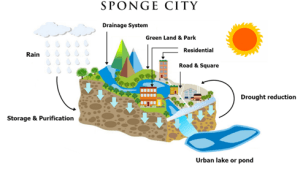TAG: GS-3: DISASTER MANAGEMENT
CONTEXT: Recently, in the Cities series, presented by Omidyar Network India and moderated by Chief Correspondent Sukrita Barua, panellists discussed how Guwahati could tackle floods and droughts.
EXPLANATION:
About Sponge City
- The “sponge city” is an urban planning model designed to use “nature-based solutions” to distribute water better and improve drainage and storage.
- Sponge cities are a new approach to urban planning that emphasizes flood management and water conservation through the strategic use of green infrastructure. This concept is inspired by nature’s ability to absorb rainwater, mimicking a sponge.
- The term “sponge city” originated in China, it refers to “a new urban planning model in China that emphasizes flood management via strengthening green infrastructures instead of purely relying on drainage systems.”

Objectives of Sponge Cities:
- Reduce urban flooding: By increasing infiltration and storage of rainwater, sponge cities aim to lessen the burden on traditional drainage systems, thereby reducing the risk of flooding during heavy rainfall events.
- Reduce water scarcity: Captured rainwater can be stored and reused for non-potable purposes like irrigation or flushing toilets, reducing reliance on strained freshwater resources.
- Mitigate urban heat island effect: green infrastructure, like trees and parks, can help to cool urban environments by providing shade and evapotranspiration (the release of water vapor from plants).
- Enhance ecological biodiversity: By creating green spaces and restoring natural waterways, sponge cities can provide habitat for various plant and animal species, promoting a more diverse urban ecosystem.
- Promote sustainable water management: Sponge cities encourage a shift towards a more natural and sustainable approach to managing water resources within urban areas.
Key elements of Sponge Cities:
Urban parks:
- Urban parks serve as multifunctional spaces within cities, providing recreational areas for residents while also serving as important components of stormwater management. They can absorb and store rainfall, reducing runoff and the risk of flooding.
Gardens:
- Gardens, including community gardens and private green spaces, contribute to the absorption of rainfall and promote biodiversity within urban environments. They enhance permeability of the soil, allowing water to infiltrate and reduce surface runoff.
Green Spaces:
- Similar to urban parks, green spaces such as lawns and landscaped areas help mitigate flooding by absorbing and storing rainfall. They also contribute to the aesthetic and environmental quality of urban areas.
Wetlands:
- Wetlands play a crucial role in stormwater management by naturally filtering pollutants and slowing down the flow of water. They provide habitat for diverse plant and animal species and help maintain ecological balance within urban ecosystems.
Nature Strips:
- Nature strips, also known as bioswales or vegetated swales, are vegetated areas typically located between sidewalks and roadways. They help capture and filter stormwater runoff, reducing pollution and minimizing the risk of flooding.
Permeable pavements:
- Permeable pavements are surfaces that allow water to infiltrate through them into the ground below. This reduces surface runoff and helps replenish groundwater supplies. Permeable pavements can include materials such as permeable concrete, porous asphalt, or interlocking pavers.
Benefits of Sponge Cities
Reduced flood risks:
- Sponge cities implement innovative stormwater management strategies that reduce surface runoff and enhance water absorption into the ground.
- By capturing and storing rainwater, sponge cities mitigate flooding risks during heavy rainfall events, protecting communities and infrastructure from water-related disasters.
Improved water quality:
- The use of green infrastructure in sponge cities helps filter and treat stormwater runoff before it enters natural water bodies.
- Vegetated elements like rain gardens, wetlands, and permeable pavements remove pollutants such as sediment, nutrients, heavy metals, and pathogens, thereby improving the quality of water that eventually reaches rivers, lakes, and oceans.
Enhanced urban aesthetics:
- Incorporating green spaces, urban parks, green roofs, and other natural elements into urban environments enhances the aesthetic appeal of cities.
- Green infrastructure not only provides functional benefits but also contributes to a more attractive and livable urban landscape, promoting well-being and community pride.
Increased resilience to climate change:
- Sponge cities are designed to adapt to and mitigate the impacts of climate change, including increased frequency and intensity of rainfall events.
- By incorporating nature-based solutions, such as wetlands, green roofs, and permeable pavements, cities become more resilient to extreme weather events, reducing vulnerabilities and ensuring sustainable urban development.
Sustainable use of water resources:
- The adoption of sponge city concepts encourages sustainable water management practices.
- By capturing and reusing rainwater, promoting groundwater recharge, and minimizing reliance on centralized drainage systems, sponge cities optimize the use of water resources. This contributes to water conservation and supports long-term sustainability of urban water systems.
Source:
Spread the Word
